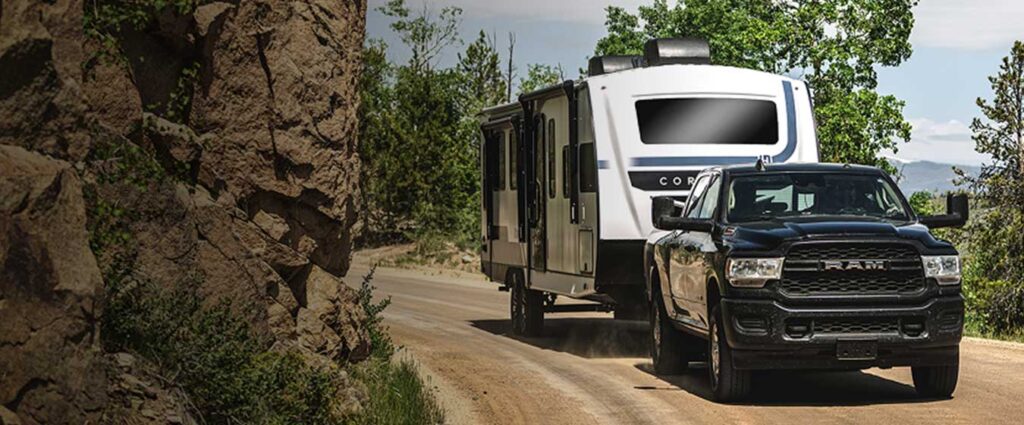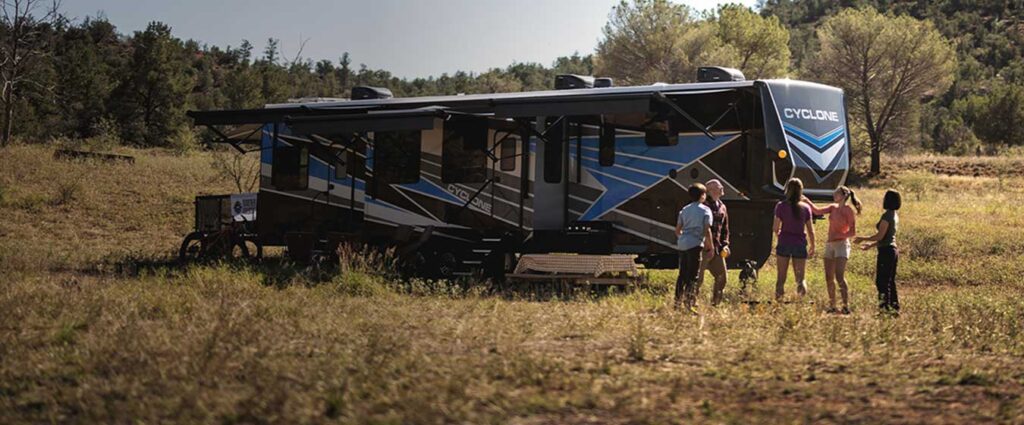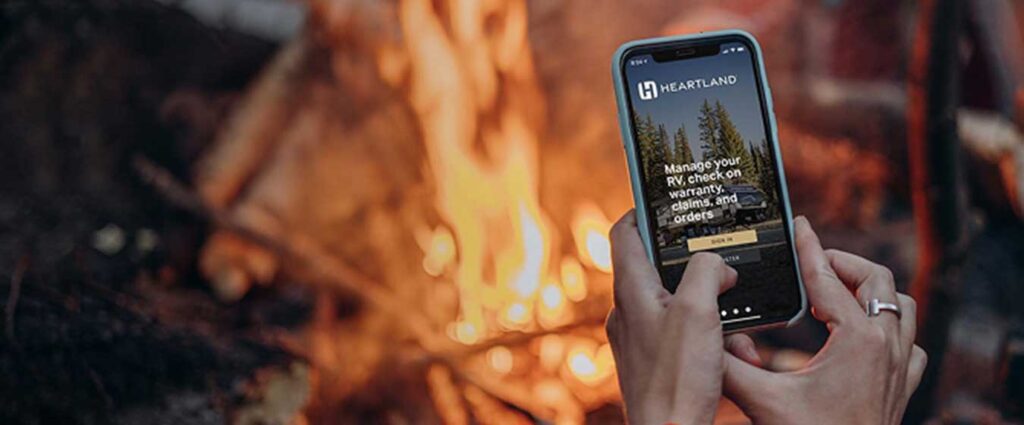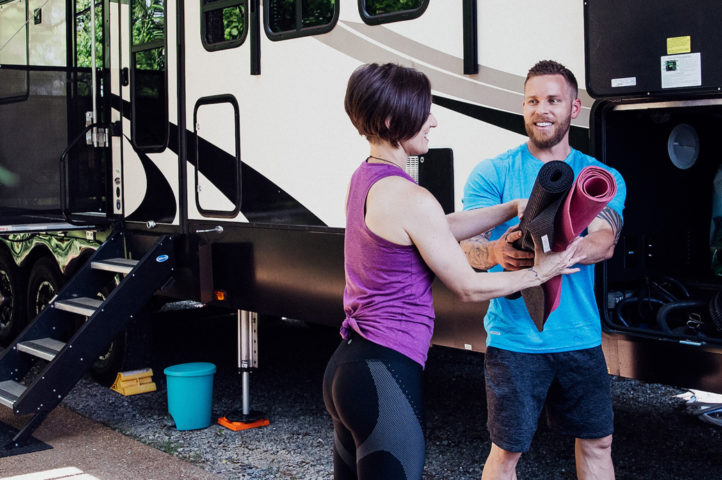Socially distanced travel has brought RVs back into the fold in a big way. Here’s how you can make sure you stick to your health goals while traveling and living in an RV.
Each product we feature has been independently selected and reviewed by our editorial team. If you make a purchase using the links included, we may earn commission.
Picture this: You’re cruising across Jackson Hole, Wyoming at dawn, best friend in the passenger seat, and pup snoring soundly on the backseat. Stretched behind you, a rented RV hauls your gear, sustenance, and sleeping abode for a rejuvenating week at the scenic campgrounds of Grand Teton National Park. You’ll be grilling, paddleboarding in Jenny Lake, and hiking picturesque trails. Once you and your crew have had your fill, you’ll be packing your bags (truck?) and heading North to Yellowstone to do it all over again. This is RV living.
As summer weaves into fall and socially distanced travel becomes the norm, RV road-tripping has increased in appeal for all wanderlust travelers out there. So much so, that in a recent survey of more than 19,000 current and prospective RV owners, nearly 50 percent of respondents are planning a trip in October, which is past typical RV season that usually ends about the end of September.
If the road is calling your name but you’re worried that embarking on an RV road-tripping adventure will undermine your ability to work out, eat healthily, and sleep well, read on. Experienced RVers share how you can stay on track with your wellness and make your RV living experience just as healthy — if not more so — than your usual grind.
Working Out While Living In an RV
Just because you won’t be setting foot inside your gym any time soon doesn’t mean you need to let go of your workout goals. After all, your body is the best piece of equipment you have, and then you can supplement with a tool or two to keep workouts interesting and keep you motivated.
Stefany Adinaro, a personal trainer and wellness coach at The Fit RV splits her time between her home of Saint George, Utah and her Winnebago Travato RV with her husband — so she’s a veritable pro at healthy RV living. She recommends purchasing a resistance band kit (Buy It, $40, amazon.com) as her ultimate “must,” and then expanding your equipment investments from there depending on your fitness level. “Purchase one that comes with door attachments or anchor mounts that can wrap around a fence, a picnic table leg, or even the RV’s running board (the “step” in and out of an RV; most trucks and vans have them) that will help turn the bands into something similar to your gym’s cable machine, giving you endless possibilities,” says Adinaro.
Next on your list should be a yoga mat.
“The coolest place I’ve unrolled my yoga mat? Right on the edge of the Grand Canyon,” says Adinaro. That’s one of the perks about exercising while road-tripping across the nation. A TRX (Buy It, $130, amazon.com) and a jump rope (Buy It, $6, amazon.com) are also small space-friendly. They pack well, and you can pretty much step outside the RV and use them anywhere.
View this post on Instagram
The RV itself can become an exercise tool.
You can use the doorstep for step-ups and leg lifts. You can stand outside and lean against it for wall planks or wall squats. And you can use the ladder for climbs, or you can lie on your back with your feet up on the running board for glute bridges. Plus, look for things in your RV that you can use as a makeshift free weight. “Most people travel with their dogs or cats, so if you have a big bag of cat litter or dog food, or a 5- or 10-gallon water jug, your propane tank, you can use those items as resistance, so you can do squats, lunges, and more using them almost as sandbags,” adds Fraser Bayley, plant-based nutritionist and co-owner of VegUp Life, who RV-travels part-time with his wife Lauren, in their 2018 Heartland Road Warrior Toy Hauler.
Now, if you’re so inclined to bring weights, don’t be discouraged…
It’s all about whether you have space for them, and if you can work it into your towing capacity. To be doubly sure how much you’re towing, you can use a truck weight station. “I have a barbell with 315 pounds, some dumbbells, tension bands, and a portable squat rack, but most people don’t have that type of storage,” says Bayley. “If you can fit anything like that, I think adjustable dumbbells are a good investment — you can have a multitude of weights with little room.”
Besides specific exercise tools, don’t forget to pack gear for your outdoor adventures
After all, perhaps the biggest perk of RV living is easy access to the outdoors. Bring your bikes, hiking poles, snowshoes, kayaks, or other things along those lines on your trips so you’ll have lots of options for keeping your RV adventures active and fun. And, since most of these items can be tied up on your roof or strapped to the back of the RV, it won’t take up any precious indoor storage.
How exactly you create your workout routine will vary with what kind of trip you’re on. “Every week can be different when you’re living in an RV, but that’s what keeps it interesting and keeps you generally fit,” says Adinaro. “If you’re in a reservoir and there’s going to be kayaking Monday, Wednesday, and Friday, then you can plan resistance training on Tuesday and Thursday.” (See: How to Create a Perfectly Balanced Week of Workouts)
The biggest takeaway is to synergize your workouts with your environment.
“If you’re boondocking in a beautiful spot or your campground has lots of room, add 50-yard sprints between exercises to shake things up, make things more challenging or increase the duration of your workout,” says Bayley. Be adaptable, and look at your natural environment to see what can double as gym equipment.
And in case of inclement weather, working out inside your RV is totally possible (there might just be some height restrictions if you’re using a travel trailer), but you could do bands or bodyweight workouts and adapt them to your small space.
View this post on Instagram
Healthy Cooking In an RV
The idea of cross-country road-tripping might have you thinking of gas station meals and microwave dinners, but RV living can absolutely include healthy eating and cooking as well. Eating nutrient-rich whole foods during your trip can give you a ton of extra energy you can use to go hiking and exploring when you travel. Not to mention, whole foods help keep your brain sharp and your mood balanced, which you’ll need on long drives.
Before embarking on your RV trip, it pays to do a little prep.
Make sure you have enough base meals frozen (think: soups and smoothie mixes for long stretches where you may not have access to healthful food or fresh produce at the ready. Adinaro likes to make healthy snacks beforehand, such as chickpea peanut butter energy bars, and quiche muffins. The most common type of fridge you’re going to find in most RVs is a “residential-style” fridge, which could be either side-by-side or top-freezer.
As you begin planning your routes, try to find stores along the way that have fresh, quality foods, and get as much there as you can. Then, on longer trips, you can bridge that gap with smaller stores that may not have as much produce available.
“As you buy things fresh, cut them up and put them in zip-top bags, (such as fruits and vegetables) and then freeze,” says Bayley. “If you’re in a small travel trailer, the fridge won’t have any power while you’re driving, so things will degrade faster. If you freeze them, they will stay cooler for longer.” And if you’d like, it wouldn’t hurt to invest in ice packs to keep stuff in the fridge cooler for longer.
While you’re on the trip, that’s an excellent time to bust out of your meal prep comfort zone.
This can look like hunting for local markets and farm stands to find fresh, and healthy foods unique to the area. (The USDA has a Farmers Market Directory you can use to search for one near your next stop.) “Seek out produce you’re less familiar with and experiment with new recipes you’ve never tried before,” says Adinaro.
An RV kitchen won’t cheat you out of the standard appliances, but it will cheat you out of an oven.
Depending on what type of RV you have, most will include a full-sized stove, full-sized sink, full-sized fridge, and either a full-size microwave or microwave/convection oven and microwave combo. For ease of cooking — and if your space can afford it — the Bayleys suggest purchasing a Crock-Pot or Instant Pot, which you can throw veggies, grains, proteins into and let it run on electric power, so it doesn’t eat up your propane tank (since most RVs use propane-powered stoves). An air fryer can also be a good investment so you can cook things with a crispy texture in a short amount of time. And of course, it’s always a good idea to bring a small blender for quick smoothies and anything that requires a food processor. Plus, you’ll often be able to use charcoal grills at campgrounds where you stop.
View this post on Instagram
Check out a few of Adinaro and the Bayley’s best RV-friendly meal ideas:
Breakfast:
- Toasted English muffin with avocado and a Morningstar sausage
- Smoothies
- Turkey and spinach omelet in a mug
Lunch & Dinner:
- Grilled local vegetables on a crusty piece of bread from a local bakery
- Macro bowls and Buddha bowls with tofu, lentils, chickpeas, potato, rice or quinoa, and a spring mix, topped off with hummus of guac
- Grilled BBQ chicken (premade from the store), corn on the cob, with fresh salad and healthy dressing
Snacks:
- Grilled peaches, with yogurt, walnuts, and a drizzle of honey
- Chia pudding
- Lemon ginger energy bites
Other Healthy Living Tips for RV Life
One of the challenges of RV living and travel is that it throws off your normal schedules and habits, so it’s important to set up some strategies before even hitting the road that will help you stay on track with your fitness goals. “Choose a day a week and create an exercise/activity schedule,” says Adinaro. “Once it’s written down, it’s more of commitment you’ll be more likely to stick to.”
Getting Good Sleep
Good sleep can be challenging in an RV for a myriad of reasons. Maybe your campground neighbors are late, or there’s a bright light shining into the RV. Some things you can do to set yourself up for a great night’s sleep is to bring a sleeping mask, earplugs, lavender essential oil, and either a small fan or white noise machine (or use a white noise app on your phone). Sleeping on a slant can also affect the quality of your sleep, so pack leveling blocks (Buy It, $28, amazon.com) if your RV doesn’t come with levelers so that you can get the RV as level as possible.
Maintaining Air Quality
Make sure you vacuum often, open your windows to let fresh air in, and that your air quality is free of airborne pollutants, such as pollen and dandruff. “In a confined space — and if you have animals — you’re going to accumulate dust and dander very quickly,” says Bayley. (And, FYI, breathing in these particles for long can cause inflammation and lead to health problems such as allergies, and asthma, according to the U.S. Environmental Protection Agency.) To keep the air clean, “we have a Molekule air purifier,” he says. (Check out these other air purifiers for your home or RV.)
Sourcing Clean Water
Lastly, make sure your water filtration system is effective and removes any trace heavy metals or pollutants. “We have one at the top of your RV that cleans water from chlorine and other minerals, and then run the tap again through a Berkey filter. Some newer RV and motorcoaches do come with filtration systems, but in most cases, they require you to get your own filter. So you should get an outdoor water filter (Buy It, $18, amazon.com) that you hook up to your water at the spicket, so it removes any chlorine and contaminants before it enters your RV so you aren’t showering or washing dishes with that water, either.
This story first appeared as an article on Shape.







